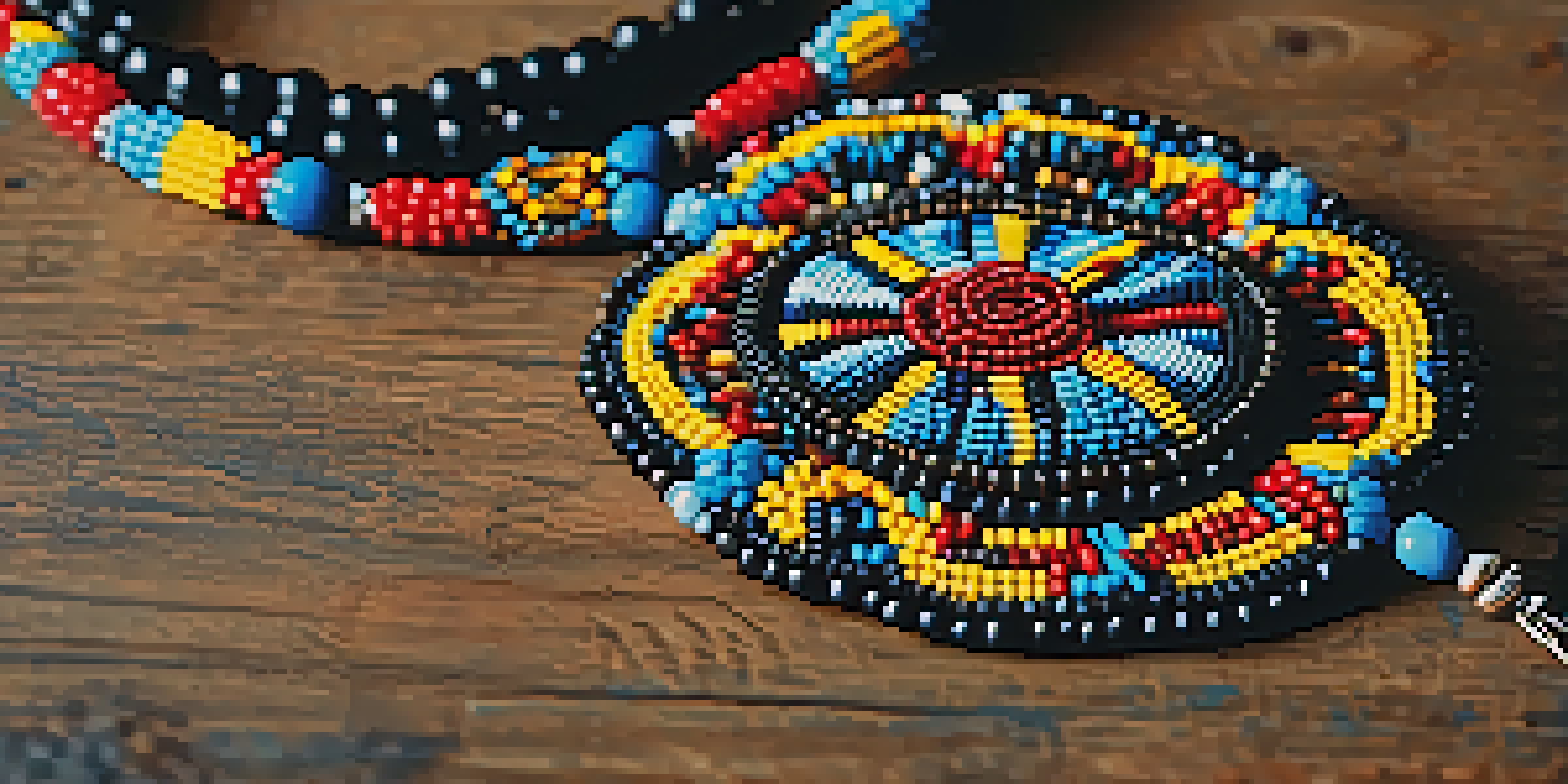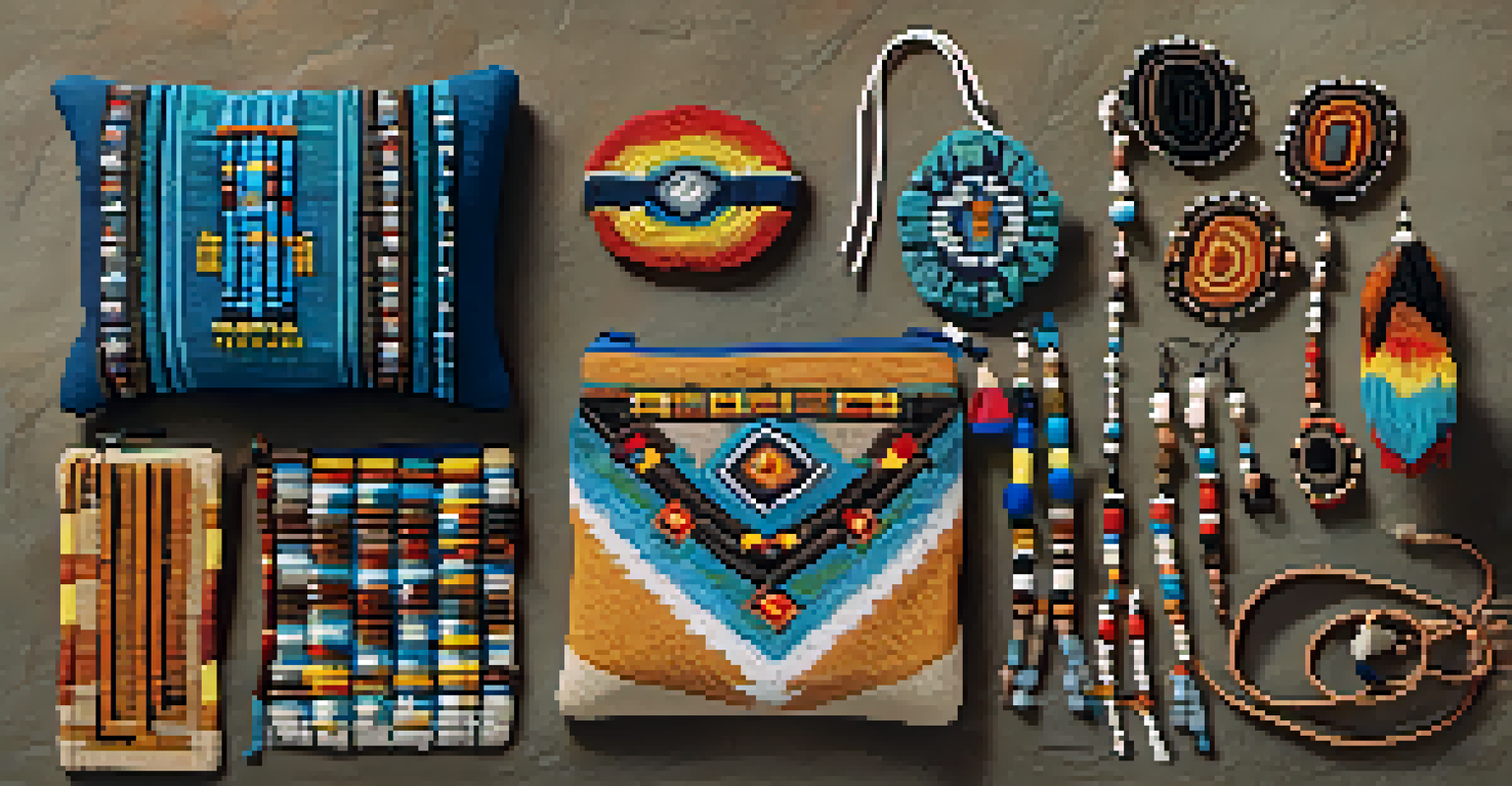Exploring Native American Beading: Crafting Cultural Stories

The Significance of Beading in Native American Cultures
Beading is more than just a craft in Native American cultures; it's a vibrant expression of identity and heritage. Each bead, color, and pattern often carries deep meanings and stories, reflecting the history and traditions of various tribes. This artistic form serves as a communication tool, conveying messages of spirituality, community, and personal journeys.
Beading is not just a craft, it’s a way to connect with our ancestors and our culture.
For many Native Americans, the act of beading connects them to their ancestors and the land they inhabit. It's a form of storytelling, where intricate designs can narrate tales of their people's struggles, triumphs, and beliefs. This rich tradition emphasizes the importance of community, as many pieces are created collaboratively, preserving shared cultural narratives.
Through beading, artisans create not just decorative items but also powerful symbols of resilience and continuity. As younger generations learn this craft, they become custodians of their culture, ensuring that the stories embedded in each bead live on. This practice fosters a sense of pride and belonging, reinforcing the ties among community members.
Materials and Techniques in Native American Beading
The materials used in Native American beading are as diverse as the tribes themselves. Traditional beads were often made from natural materials such as seeds, shells, and stones, while modern artisans might incorporate glass beads and metal components. Each material holds significance and can alter the meaning and aesthetic of the finished piece.

Techniques vary widely across different tribes, with each group having its unique style. Common methods include loom weaving, embroidery, and appliqué, allowing for a vast array of designs and textures. As artisans experiment with these techniques, they often blend traditional elements with contemporary influences, creating a dynamic conversation between past and present.
Beading as Cultural Expression
Beading serves as a vibrant expression of identity and heritage for Native Americans, reflecting stories, spirituality, and community ties.
The creative process of beading often involves meticulous planning and patience. Artisans may sketch designs before beginning, ensuring that every bead placement tells a part of the story. This dedication not only showcases their skill but also honors the cultural significance of the craft, making each piece a labor of love and a testament to their heritage.
Symbolism in Bead Colors and Patterns
Colors and patterns in Native American beading are rich with symbolism, often representing various aspects of life, nature, and spirituality. For example, the color red might symbolize courage, while blue can represent peace and tranquility. Understanding these meanings adds depth to the appreciation of each beaded piece.
Each bead tells a story, and in every pattern, there is a history waiting to be shared.
Patterns can also convey messages, with geometric shapes often symbolizing elements from nature or important cultural motifs. For instance, a spiral might represent life’s journey, while a zigzag could symbolize lightning or the path of a river. These designs connect the wearer not only to their culture but also to the universe around them.
As artisans create their pieces, they carefully choose colors and patterns to express personal stories or communal values. This intentionality transforms each item into a narrative thread, weaving the wearer’s identity with their cultural heritage. Ultimately, beadwork becomes a living history, where each piece carries the weight of tradition and the vibrancy of individual expression.
The Role of Beading in Cultural Identity
Beading plays a crucial role in shaping cultural identity among Native Americans. For many, the craft is a way to reclaim and celebrate their heritage, especially in a world that often overlooks indigenous narratives. Through beading, individuals can express their unique identities while also connecting to their community’s shared history.
Crafting beadwork can serve as a form of resistance against cultural erasure. As artisans proudly display their work, they challenge stereotypes and promote awareness of their traditions. This visibility helps foster understanding and appreciation for Native American cultures, creating bridges between different communities.
Symbolism in Colors and Patterns
The colors and patterns in Native American beadwork carry deep symbolism, representing aspects of life, nature, and cultural narratives.
Moreover, beading is often a communal activity, bringing people together for workshops, gatherings, or family events. These shared experiences strengthen bonds and ensure the transmission of cultural knowledge to future generations. By participating in this craft, individuals contribute to a collective narrative that celebrates resilience and continuity.
Beading as a Form of Storytelling
Each bead and stitch in Native American beadwork tells a story, often steeped in personal or communal experiences. Artisans use their creations to share memories, legends, and lessons learned over time. This storytelling aspect transforms the beadwork into a living archive of cultural heritage.
For example, a necklace might represent a significant life event, such as a coming-of-age ceremony or a wedding. Similarly, a pair of earrings might honor a family member or cultural hero. Through these pieces, artisans preserve their histories and pass them down to future generations, ensuring that these stories continue to be told.
As audiences engage with these works, they too become part of the narrative. Wearing or appreciating Native American beadwork opens a dialogue about culture, history, and identity, fostering a deeper understanding of the values and experiences that shape these communities. Thus, beadwork becomes a bridge connecting the past with the present.
Modern Innovations in Native American Beading
While traditional techniques and designs remain vital, modern Native American artisans are also innovating within the craft. Many are experimenting with contemporary materials, styles, and methods, creating pieces that resonate with both indigenous and broader audiences. This fusion of old and new helps keep the art form alive and relevant.
Social media platforms have also played a significant role in this evolution, allowing artisans to share their work and connect with a global audience. Through platforms like Instagram and Etsy, beaders can showcase their creations, gain recognition, and even sell their pieces. This exposure has led to a resurgence of interest in Native American beadwork, particularly among younger generations.
Modern Innovations in Beading
Contemporary Native American artisans are blending traditional techniques with modern influences, keeping the art form dynamic and relevant.
These innovations do not erase traditional practices; rather, they enhance them, creating a dialogue between the past and present. As artisans continue to push the boundaries of beadwork, they ensure that it remains a dynamic and evolving form of cultural expression. This adaptability is crucial for the survival and growth of Native American art in a rapidly changing world.
Supporting Native American Artisans and Beading Communities
Supporting Native American artisans is essential for preserving their cultural practices and promoting economic sustainability. By purchasing beadwork directly from artisans or community-owned shops, individuals can contribute to the livelihoods of these creators and their families. This support not only fosters economic independence but also reinforces the value of cultural heritage.
Attending local craft fairs, workshops, and exhibitions can also be a great way to appreciate and support Native American beading. These events often provide a platform for artisans to showcase their work, share their stories, and connect with the community. Engaging with these events enriches the cultural fabric of the area and creates a vibrant space for dialogue and learning.

Additionally, advocating for policies that support indigenous artists and their rights can help ensure the protection of their cultural expressions. By raising awareness about the importance of Native American art, individuals can play a crucial role in preserving these rich traditions for future generations. Supporting these communities ultimately benefits everyone, as it promotes diversity and understanding within society.